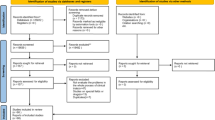Abstract
Background A new clinical trial guideline for Chinese Medicine (CM) was published in 2015, which incorporates the characteristics of traditional approaches of practice with the practical recommendations of rigorous research methodology. Objectives This chapter aimed to introduce the research methodology for CM practice and the key considerations that need to address in relation to the characteristics of CM as a whole system. Details This chapter includes the introduction of basic study design, key issues on planning, implementing, and analyzing and reporting a clinical study of CM. The principles of clinical study design, basic research methods for interventional studies (e.g., randomized controlled trial), observational studies (e.g. cohort study, case-control study, case series study and case report), and systematic reviews were introduced in the first section. For each type of study, research model, scope of application, merit and weakness were addressed in accordance with the characteristics of CM. In the second section, we introduce details of methods of planning (research question, study protocol, sample size, study settings, participants, comparisons, and outcome measures), implementing (allocation sequence generation, blinding method, ethical approval, bias control, data management and monitoring), and analyzing (statistical methods, analysis and interpretation of results) a CM clinical study. Adequate examples from previous publications are shown to give clues and deepen understanding on each issue. Conclusions It is our hope that this chapter will encourage a thoughtful and meticulous process of investigation to provide reliable evidence for CM therapies for better health care.
Access this chapter
Tax calculation will be finalised at checkout
Purchases are for personal use only
Similar content being viewed by others
References
Liu JP, et al. Study methods of evidence-based Chinese medicine. Beijing: People’s Health Press; 2010. pp. 21–4.
Witt CM, Linde K. Clinical research in complementary and integrative medicine: a practical training book. Hackerbrucke: Urban and Fischer; 2012. pp. 65–74.
Pocock SJ. Clinical trials: a practical approach. John Wiley and Sons; 1983. pp. 97–9.
Cao H, et al. Medicinal cupping therapy in 30 patients with fibromyalgia: a case series observation. Forsch Komplementmed. 2011;18:112–6.
Zhang L, et al. Prevalence of chronic kidney disease in China: a cross-sectional survey. Lancet. 2012;379:815–22.
Hsu PC, et al. Integrating traditional Chinese medicine healthcare into diabetes care by reducing the risk of developing kidney failure among type 2 diabetic patients: a population-based case control study. J Ethnopharmacol. 2014;156:358–64.
Su SY, et al. Use of Chinese medicine correlates negatively with the consumption of conventional medicine and medical cost in patients with uterine fibroids: a population-based retrospective cohort study in Taiwan. BMC Complement Altern Med. 2015;15(1):129.
Zhang CS, et al. Ear acupressure for perennial allergic rhinitis: a multicenter randomized controlled trial. Am J Rhinol Allergy. 2014;28(4):e152–7.
Witt CM, et al. Homoeopathic versus conventional therapy for atopic eczema in children: medical and economic results. Dermatology. 2009;219(4):329–40.
Liu JP, Chen KJ. The guideline development team. Methodology guideline for clinical study investigating traditional Chinese medicine and integrative medicine. Complement Ther Med. 2015;23:751–6.
Kim SY. Comparative effectiveness research in primary practice. Korean J Fam Med. 2012;33:329.
Mayer D. Essential evidence-based medicine (second edition). Cambridge: Cambridge University Press; 2010. pp. 367–78.
Higgins JPT, Green S (editors). Cochrane handbook for systematic reviews of interventions version 5.1.0 [updated March 2011]. The Cochrane Collaboration, 2011. Available from www.cochrane-handbook.org.
Cao H, et al. Cupping therapy for acute and chronic pain management: a systematic review of randomized clinical trials. J Tradit Chin Med Sci 2014; 1:49e61.
Manheimer E, Wieland S, Kimbrough E, Cheng K, Berman BM. Evidence from the cochrane collaboration for traditional Chinese medicine therapies. J Altern Complement Med. 2009;15(9):1001–14.
Cao H, et al. Using a partially randomized patient preference study design to evaluate the therapeutic effect of acupuncture and cupping therapy for fibromyalgia: study protocol for a partially randomized controlled trial. Trials. 2014;15:280.
Liu JP, et al. Prospective registration, bias risk and outcome-reporting bias in randomised clinical trials of traditional Chinese medicine: an empirical methodological study. BMJ Open. 2013; 3(7):pii:e002968.
Stroup DF, et al. Meta-analysis of observational studies in epidemiology: a proposal for reporting. JAMA. 2000;283(15):2008–12.
Acknowledgments
Huijuan Cao was supported by the 2015 Beijing Organization Department Outstanding Talented Person Project (Grant No. 2015000020124G083); Both Huijuan Cao and Jianping Liu were supported by a Construction Project from the Beijing Municipal Education Commission.
Author information
Authors and Affiliations
Corresponding author
Editor information
Editors and Affiliations
Rights and permissions
Copyright information
© 2016 Springer Science+Business Media Singapore
About this chapter
Cite this chapter
Cao, Hj., Liu, Jp. (2016). Methodology for Clinical Study Investigating Chinese Medicine. In: Leung, Sw., Hu, H. (eds) Evidence-based Research Methods for Chinese Medicine. Springer, Singapore. https://doi.org/10.1007/978-981-10-2290-6_2
Download citation
DOI: https://doi.org/10.1007/978-981-10-2290-6_2
Published:
Publisher Name: Springer, Singapore
Print ISBN: 978-981-10-2289-0
Online ISBN: 978-981-10-2290-6
eBook Packages: MedicineMedicine (R0)




